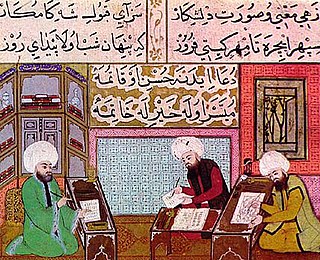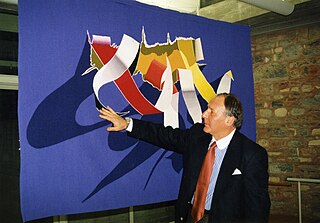Related Research Articles

Ottoman miniature or Turkish miniature was a Turkish art form in the Ottoman Empire, which can be linked to the Persian miniature tradition, as well as strong Chinese artistic influences. It was a part of the Ottoman book arts, together with illumination, calligraphy, marbling paper, and bookbinding. The words taswir or nakish were used to define the art of miniature painting in Ottoman Turkish. The studios the artists worked in were called Nakkashanes.

Turkish art refers to all works of visual art originating from the geographical area of what is present day Turkey since the arrival of the Turks in the Middle Ages. Turkey also was the home of much significant art produced by earlier cultures, including the Hittites, Ancient Greeks, and Byzantines. Ottoman art is therefore the dominant element of Turkish art before the 20th century, although the Seljuks and other earlier Turks also contributed. The 16th and 17th centuries are generally recognized as the finest period for art in the Ottoman Empire, much of it associated with the huge Imperial court. In particular the long reign of Suleiman the Magnificent from 1520 to 1566 brought a combination, rare in any ruling dynasty, of political and military success with strong encouragement of the arts.

Eczacıbaşı Holding is a Turkish industrial group of companies founded in 1942. The group with 44 companies has 11,400 employees and a combined net turnover of TL 11.1 billion in 2020.
Nasuh bin Karagöz bin Abdullah el-Visokavi el-Bosnavî, commonly known as Matrakçı Nasuh for his competence in the combat sport of Matrak which was invented by himself, was a 16th-century Bosniak statesman of the Ottoman Empire, polymath, mathematician, teacher, historian, geographer, cartographer, swordmaster, navigator, inventor, painter, farmer, and miniaturist.

Turkish or Ottoman illumination covers non-figurative painted or drawn decorative art in books or on sheets in muraqqa or albums, as opposed to the figurative images of the Ottoman miniature. In Turkish it is called “tezhip”, meaning “ornamenting with gold”. It was a part of the Ottoman Book Arts together with the Ottoman miniature (taswir), calligraphy (hat), bookbinding (cilt) and paper marbling (ebru). In the Ottoman Empire, illuminated and illustrated manuscripts were commissioned by the Sultan or the administrators of the court. In Topkapi Palace, these manuscripts were created by the artists working in Nakkashane, the atelier of the miniature and illumination artists. Both religious and non-religious books could be illuminated. Also sheets for albums levha consisted of illuminated calligraphy (hat) of tughra, religious texts, verses from poems or proverbs, and purely decorative drawings.

Nusret Çolpan was a Turkish painter, architect and miniaturist, renowned for his paintings in Ottoman miniature style depicting cities around the world, particularly Istanbul. He painted over 300 miniatures in his 30-year career.

Füreya Koral was a pioneering ceramics artist born into a prominent artistic family in Turkey.

Nurhan Atasoy is a Turkish art historian. She specializes in history of Ottoman and Islamic art. She served as a Chair in the Department of Fine Arts, Archeology and Art History at Istanbul University until 1999 when she retired. She is a resident scholar of the Turkish Cultural Foundation.

Sencer Sarı is a Turkish ceramicist, sculptor, ceramic & glass technology expert, and academic researcher.

The TGC Press Media Museum, aka Istanbul Press Media Museum, is a history and technology museum dedicated to mass communication in Turkey featuring exhibitions about journalism. It is located in the Çemberlitaş neighborhood of Fatih district in İstanbul, Turkey. Established in 1988, it is owned and operated by the Journalists Association of Turkey.

Deniz Sağdıç is a Turkish artist. She began her art education at Mersin University's Faculty of Fine Arts in 1999. She was included in various projects even as a student. She graduated with a first from the same university in 2003. The young artist who has featured in many international and national projects and ate.
Alev Ebüzziya Siesbye is a Turkish-Danish ceramic artist. Siesbye designed ceramic wares for the ceramic companies Royal Copenhagen and Rosenthal AG. In 2009, Siesbye was awarded the Chevalier de l'Ordre des Arts et des Lettres for her ceramic designs.
Zehra Say was a Turkish painter and first Turkish woman to be officially married under the 1926 Civil Marriage law. She is known as one of the pioneering women of Atatürk's Turkey for her modern look on women's equality. As an artist she is known for her paintings of nature, flowers and fruits. Her great love of nature reflected in her paintings as she depicted Istanbul in a different light. Her work is described as an realistic interpretation of nature. She is the mother of painter Emel Say and grandmother of pianist Fazil Say.

Yahşi Baraz is a Turkish art dealer. He is the founder and the director of one of Turkey's earliest art galleries, Galeri Baraz.

Nezihe Bilgütay Derler is a Turkish miniaturist, known for her Çini, a traditional Turkish artform made on a layer of fusion between glass and porcelain. Her Çini patterns are widely used.
Nihal Güres is a Turkish artist and writer.
Mesude Hülya Şanes Doğru is a Turkish master craftsman, ceramic decorator and academic, trained in the art of miniature.
Neşe Aybey (1930-2015), also written Neş'e Aybey, was a Turkish Painter, Miniaturist and Academic in the field of miniature art, one of the Traditional Turkish Arts and part of the Ottoman Book Arts. She was the older sister of sculptor Gürdal Duyar.
Deniz Artun is a Turkish curator and writer.
Yusuf Taktak is a Turkish artist and academic. He was a student of and later taught in Adnan Cokers atelier.
References
Citations
- ↑ Amil, Dilruba. "Yaşanmışlıkların değerini anlatan sanat: Kintsugi". www.trthaber.com (in Turkish). TRT Haber . Retrieved 2022-09-25.
- 1 2 3 "Alev Demirkesen". www.turkishculture.org. Turkish Cultural Foundation. 25 September 2022. Retrieved 2022-09-25.
- 1 2 3 Karabay, Zambak (23 January 2020). "Alev Demirkesen & Reng - i Ahenk". oncevatan.com.tr (in Turkish). Retrieved 2022-09-25.
- ↑ admin (2019-03-22). "Alev Demirkesen 6. Kişisel Sergisini Açtı". Maxi Haber (in Turkish). Retrieved 2022-09-25.
- ↑ "Geçmişten günümüze Anadolu kadını konuşuldu". Anayurt Gazetesi (in Turkish). 2021. Retrieved 2022-10-02.
- ↑ ""Bahar-ı Alem" Karma sergisi | Sakarya Üniversitesi Haber Sitesi". haber.sakarya.edu.tr. Sakarya University . Retrieved 2022-09-25.